News
Jewels in the Muck
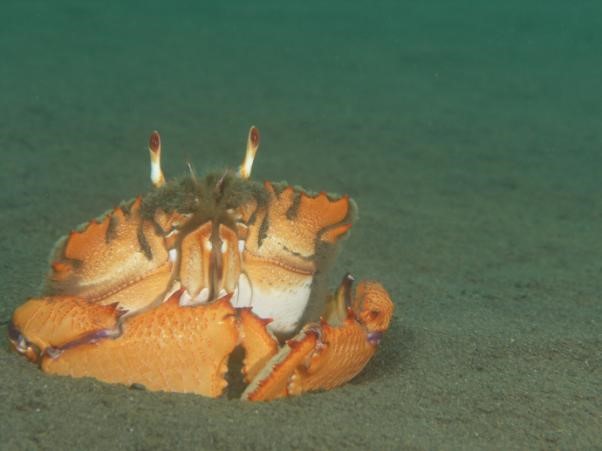
Muck diving in Bali
There is nothing as satisfying as a cup of hot strong sweet black Balinese coffee, served in a glass on the beach after your first muck dive. And there is nothing as astonishing as the critters you find in the old car tyres, empty beer bottles, lost bikini tops and empty foil packets covered in ancient volcanic ash silt.

Adi Assri Resort
This is Muck Diving in Bali. As a spoiled South African Sodwana Bay diver and a confirmed addict of well-balanced reefs, pristine corals and beautiful shoals, I had never realised that there could be a secret thriving world of resourceful marine life in the desert wastes of the undersea world, where tides regularly sweep away their habitat and man provides most of their hiding places.
It was a 10 hour flight on Air Malaysia to Kuala Lumpur, then a short 2.5 hour transfer to Bali, which is 6 hours ahead of South Africa. We paid extra for the VIP Meet and Greet and Border Visa service offered by our Dive Operator and we were whisked through the airport immigration as “crew” and through customs in 5 minutes. The Dive Operator’s air-conditioned mini bus carried us through the ancient Spice Island plantations of cinnamon, nutmeg and cloves, and we arrived at the Adi Assri resort in Gilimanauk, home for our first week. We spent the next day getting used to the new time zone and discovering that fruit and fresh vegetables are very big in Bali, Bintang Beer excellent, and Balinese food is best – Hindu’s are not big on beef, so avoid steaks at all costs. Magnum ice-cream is everywhere. Cash is best from ATMs, not money changers who cheat; plastic accepted in urban areas.
Secret Bay
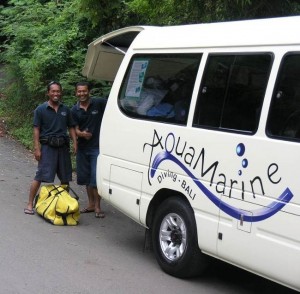
Parman and Wayan
Secret Bay on the North-western tip of Bali is mind-blowingly ugly. Surrounded by mud flats and mangroves with dirty black sand covered in silt deposits, this world famous dive site looked truly awful. It is tidal, so you have to dive it when the tide is rising, or it’s too murky to see. You have to completely change your perception of marine life. It is not all as delicate and fragile as we think. Some of it is tenacious, vigorous and adaptable, and the rarest life forms are found in the most inhospitable places.
We had elected to pay extra for a private dive guide and Parman the dive guide and Wayan the driver were to be our mentors for our entire 25 day stay in Bali.
At the shore entry point there was everything a diver needs – change rooms, showers, cleanish Balinese loos with no paper but a sort of bum-shower arrangement that was a bit disconcerting until one got the hang of it, fresh water troughs where our mentors rinsed the gear, and an ethnic cafe bar where we had lunch, part of the dive package. We kitted up on shore, and sank gently in 28 degree crystal clear water and silt coated rubbish. Finning cautiously to avoid stirring up the silt we drifted down to a maximum depth of 8 metres, scouring the silt for critters.
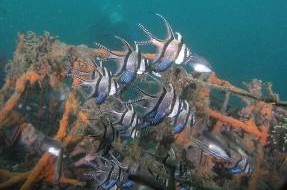
Bangai Damsels
In a pile of discarded burglar guards, we found the first of the muck jewels – a school of Banggai Damsels. Long- spined sea urchins hosted the juveniles, who later graduate to bigger hideouts.
Then Parman found a Mimic Octopus. This was incredible luck, as he is still un-described. He defends himself from predators by mimicking poisonous or unpalatable creatures. He was outraged at being spotted, and quickly reformatted himself into a poisonous brittlestar, hoping he would fool us.
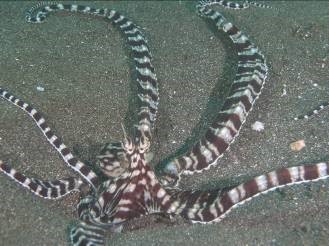
Mimic Octopus
We saw drifts of shrimpfish, bobbing mouth-down as they hoovered up minute particles of food; we saw common and rare seahorse, a plumed shrimp and coral crabs, a juvenile Oriental Sweetlips, schools of batfish, fusiliers and cardinals, both familiar and rare. There were poisonous banded sea-snakes, coiled in hollows, covered in silt and disguised as sea cucumber turds. Our last find was the highly sought after Mandarin fish (Synchiropus Splendidus). He was hiding in a pile of discarded nets, and exquisitely colourful.
Critters are nervous. They can never be sure whether their homes will still be there when they return from feeding, as the plastic bags move with the currents and the tides. It needs a trained eye to spot them and Parman had an amazing knack for finding rare things. We spent 180 minutes underwater over our 2 dives, used up all our air and took 380 photographs. It was one of the most outstanding sites I have ever dived.
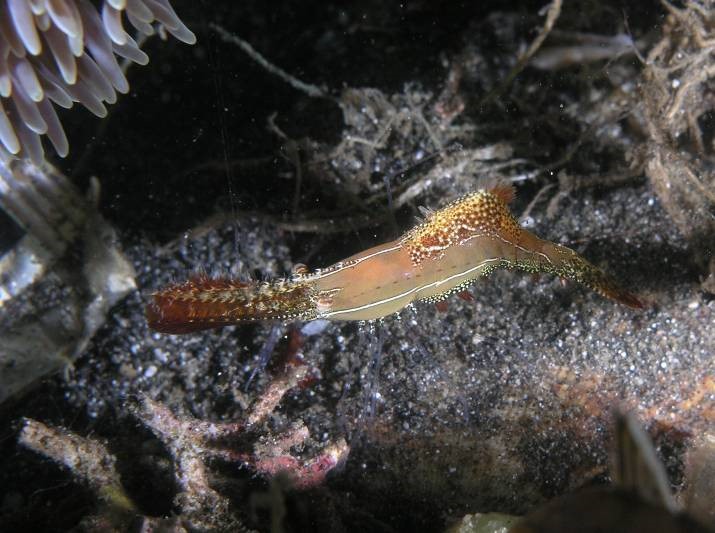
Plumed Shrimp (Leander Piumosus). Rare and gorgeous.
That evening we discovered Bali’s second best secret. There are skilled masseurs all over the island, most hotels and resorts have spas and they all offer Balinese massage. You haven’t lived till you’ve tried one. It costs around R150, lasts an hour or so and creates the most blissfully languid feeling after a hard day’s work lying in warm water looking at beautiful things.
Puri Jati
Spanner Crabs and Snake Eels
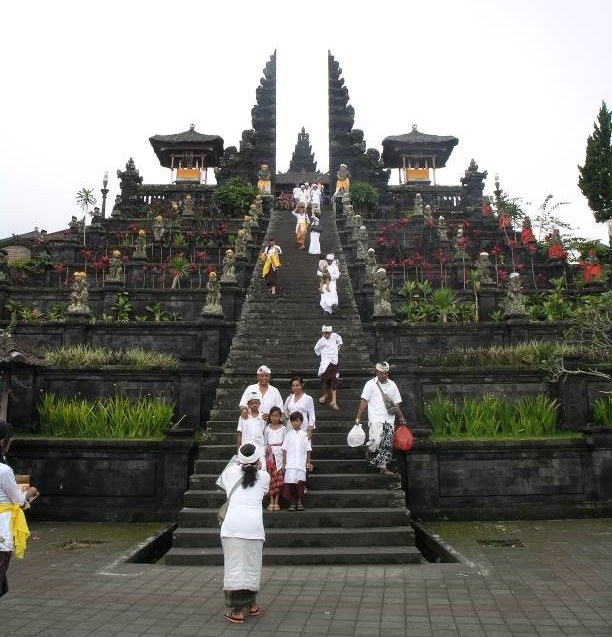
Temples
Our next major dive site was Tulamben where we were to spend another week. On the way we stopped for two dives at Puri Jati, a small Northern coastal farming community, where families cultivate the rice using hysterical little two-wheeled tractors. Wherever we went there were little palm baskets of flowers and rice in miniature temples and on pathways. We enjoyed the flowers, the birds ate the rice. This culture of sharing one’s bounty with others pervades Balinese culture, and makes for a wonderful feeling of harmony on the island. The only Hindu Island in Islamic Indonesia, Bali is volcanic, suffers occasional earthquakes and their Hindu religion pacifies their gods and keeps the volcano quiet. Rice paddy terraces are everywhere, and temples and exotic flower gardens in even the humblest homes.
In Bali, a diver’s most basic needs are met at every dive site. Our gear was carried down to the beach and again, we kitted on the shore. In Bali the men take care of the gear while the women are the porters. We sank into crystal clear water, on strangely round-grained fine sand with very little silt. But this was desert. No rubbish or rubble, nothing but sand.
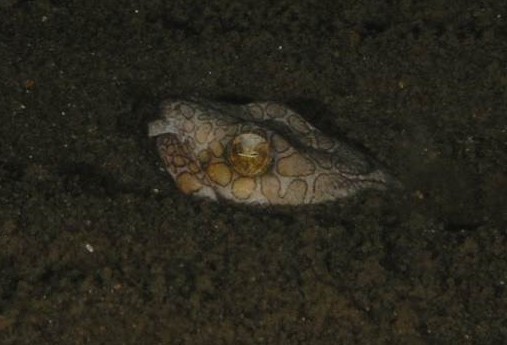
Napoleon Snake Eel (Ophrychthys Bonaparti)
We wandered after Parman, wondering why we were wasting time on this barren place, when his critter hooter sounded and we finned up to him. It was a Pegasus Sea Moth. Rarely spotted, this solitary sand dweller was walking purposefully across the sand on his “feet” – his fused pectoral fins. And right beside it was the most exquisite little creature, swallowing and gasping and finning round in circles – a very juvenile pufferfish, the size of a thumb nail.
As the sandy bottom began to slope we found a mooring rope attached to a pair of old car tyres. Inside was this exquisite, juvenile lion fish right beside the elusive and quite beautiful Ornate Ghost Pipefish. The colours of the stripes were the same on both, and they looked almost as though they had been colour-matched by an interior designer.
The slop began to come alive as we got used to a whole new way of looking at the undersea world. Suddenly we began to notice the minute partner shrimps in the anemones, the strange yellow and brown blobs in the sand that were three types of snake eels. All you could see of them was their snouts and their unblinking eyes, and rare and unusual creatures began to come into focus. There were half a dozen species of lizard fish. There was a drab brown silt covered sea horse that shied away as we approached. There was a minute squat lobster clinging to a sea pen, and a minute red juvenile frogfish.
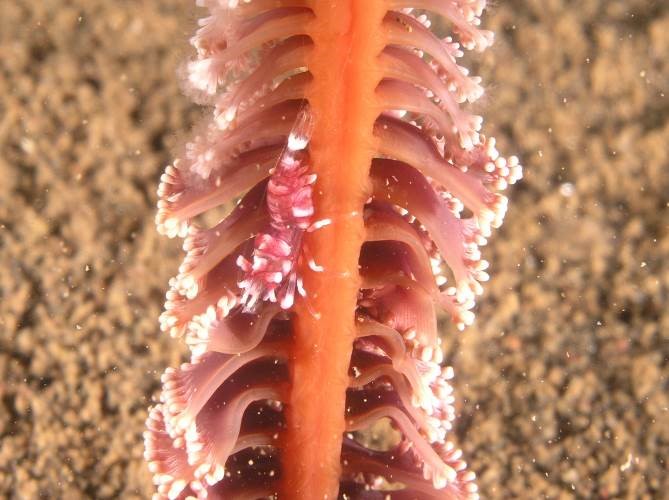
Commensual Sea Pen Shrimp (not identified)
One creature needed no such focus though. He was 15cm across, planted four-square in the sand, hunkered down and immovable, and he made Parman’s day. We were still too unfamiliar with the Bali fauna to know how privileged we were to see him. He normally lies completely buried in sand, and our bible, Ferraris’ book Macrolife has a picture of him. It shows only his eyes and his antennae. He was a Spanner Crab (Ranina ranina), hard to spot, rarely seen, and posing for pictures. Parman’s smile lit up the micro-bus all the way to Tulamben.
Seraya Slope, Tulamben
Soft Silt and Giant Mantis Shrimps
The ash based silt coating the volcanic slope at Seraya, Tulamben was so fine that it was almost impossible to fin anywhere without clouding the water. As we inched cautiously across the rocky slope we noticed some large holes each about 12 centimeters across and beautifully lined with fine vegetable matter. Clearly the architect was a master of materials control, since they remained stable even in the friable silt. We had no idea what could have made them.
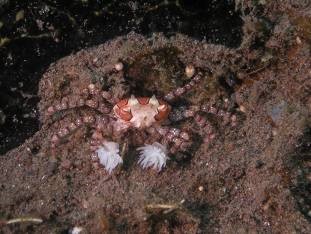
Boxer Crab (Lybia tesselata)
Our first critter was the Boxer Crab (Lybia tesselata). Difficult to find, shy and retiring, he arms the tips of his chelipeds with anemones whose sting protects him from predators. This rare and beautiful crab was out in the open, with his defences raised and a belligerent look on his face. He clearly had no idea how big we were, and was quite willing to fight us off if necessary. There were clumps of stunningly beautiful chrinoids, in every conceivable colour, and amongst them Parman found the Chrinoid squat lobster (Alogalathea elegans). It was not until we identified these two in Macrolife that we realised how rare these sightings were.
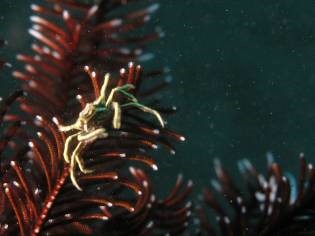
Chrinoid squat lobster (Alogalathea elegans)
As we reached the end of the dive Parman again found one of the mysterious lined holes, and began to scratch around the edges. We peered into the hole, and watched in astonishment as the most amazing creature began to emerge. The size of a rugby ball, it had 2 double eyes, and it looked like a Star Wars android. It was the Giant Mantis Shrimp, (Lysiosquillina lisa) the legendary creature capable of shattering the camera’s Ikelite lens housing. However, it was feeling benevolent, and posed for several photographs before growing bored and ducking back into its hole.
The Balinese people are essentially joyful, good humoured and happy. Thank you we say, you’re welcome, they reply with a smile, and they really mean it. When your world could vanish overnight with an exploding mountain on your doorstep, and an angry sea might threaten a tsunami, you have to be pretty philosophical. And if tourism is your source of revenue in a competitive world, you also have to be pretty cheap.
Bali
How to get there:
Malaysian Airlines
Who to dive with:
Aquamarine Diving is Bali’s only dive operation run by a British woman and is gob-smackingly efficient.
- Air-conditioned Land Transport
- Resort Accommodation
- Diving
- Lunch and Bottled Water
Best of Bali package: 8 days, 14 dives; accommodation included
Best time to travel:
March-October
References and Critter Identification:
- Macrolife by Andrea and Antonella Ferrari
- Fish Guide Indopacific by Helmut Debelius
- Marine Fishes of South East Asia by Gerry Allen
Words: Jill Holloway
Pics: David Holloway
News
Dive Worldwide Announces Bite-Back as its Charity of the Year

Over the next 12 months, specialist scuba holiday company Dive Worldwide will be supporting Bite-Back Shark & Marine Conservation with donations collected from client bookings to any one of its stunning dive destinations around the world. The independently-owned operator expects to raise £3000 for the UK charity.
Manager at Dive Worldwide, Phil North, said: “We’re especially excited to work with Bite-Back and support its intelligent, creative and results-driven campaigns to end the UK trade in shark products and prompt a change in attitudes to the ocean’s most maligned inhabitant.”
Bite-Back is running campaigns to hold the media to account on the way it reports shark news along with a brand new nationwide education programme. Last year the charity was credited for spearheading a UK ban on the import and export of shark fins.
Campaign director at Bite-Back, Graham Buckingham, said: “We’re enormously grateful to Dive Worldwide for choosing to support Bite-Back. The company’s commitment to conservation helps set it apart from other tour operators and we’re certain its clients admire and respect that policy. For us, the affiliation is huge and helps us look to the future with confidence we can deliver against key conservation programmes.”
To launch the fundraising initiative, Phil North presented Graham Buckingham with a cheque for £1,000.
Visit Dive Worldwide to discover its diverse range of international scuba adventures and visit Bite-Back to learn more about the charity’s campaigns.
MORE INFORMATION
Call Graham Buckingham on 07810 454 266 or email graham@bite-back.com
Gear News
Scubapro Free Octopus Promotion 2024

Free Octopus with every purchase of a SCUBAPRO regulator system
Just in time for the spring season, divers can save money with the FREE OCTOPUS SPRING PROMOTION! Until July 31st SCUBAPRO offers an Octopus for free
with every purchase of a regulator system!
Get a free S270 OCTOPUS with purchase of these combinations:
MK25 EVO or MK19 EVO with A700
MK25 EVO or MK19 EVO with S620Ti
MK25 EVO or MK19 EVO with D420
MK25 EVO Din mit S620Ti-X
Get a free R105 OCTOPUS with purchase of the following combinations:
MK25 EVO or MK19 EVO with G260
MK25 EVO or MK17 EVO with S600
SCUBAPRO offers a 30-year first owner warranty on all regulators, with a revision period of two years or 100 dives. All SCUBAPRO regulators are of course certified according to the new European test standard EN250-2014.
Available at participating SCUBAPRO dealers. Promotion may not be available in all regions. Find an authorized SCUBAPRO Dealer at scubapro.com.
More information available on www.scubapro.com.
-

 News3 months ago
News3 months agoHone your underwater photography skills with Alphamarine Photography at Red Sea Diving Safari in March
-

 News3 months ago
News3 months agoCapturing Critters in Lembeh Underwater Photography Workshop 2024: Event Roundup
-

 Marine Life & Conservation Blogs3 months ago
Marine Life & Conservation Blogs3 months agoCreature Feature: Swell Sharks
-

 Blogs2 months ago
Blogs2 months agoMurex Resorts: Passport to Paradise!
-

 Blogs2 months ago
Blogs2 months agoDiver Discovering Whale Skeletons Beneath Ice Judged World’s Best Underwater Photograph
-

 Gear Reviews2 weeks ago
Gear Reviews2 weeks agoGEAR REVIEW – Revolutionising Diving Comfort: The Sharkskin T2 Chillproof Suit
-

 Marine Life & Conservation2 months ago
Marine Life & Conservation2 months agoSave the Manatee Club launches brand new webcams at Silver Springs State Park, Florida
-

 Gear Reviews3 months ago
Gear Reviews3 months agoGear Review: Oceanic+ Dive Housing for iPhone
















